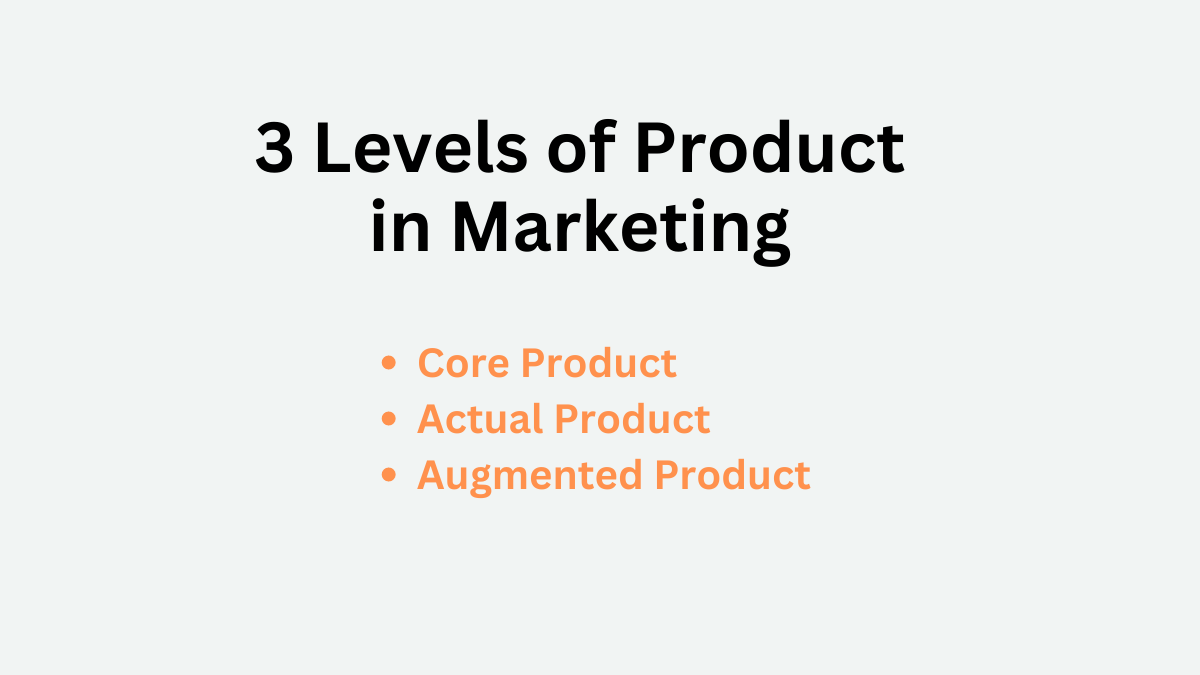The 3 Levels of Product
We often consider the product as the physical thing that we buy or hold. But, the product forms three levels – core, actual, and augmented products.
In marketing, the product is studied under three levels. Let’s understand these three levels of product and better understand what makes the product.
Core Product
The core product represents the essential function or benefits that a product offers to meet a customer’s primary need or desire. The core product is the first product from the 3 levels of product.
It addresses the fundamental reason why a customer would purchase the product, providing the core value or utility that fulfills their specific requirement or aspiration. Its four key features include:
Read More: Generic Product – Definition
- Main Purpose: This is what the product is really about like a phone’s main job is to help you communicate.
- Customer Need: It meets a specific need or desire you have as a car gets you from one place to another.
- Problem Solver: It addresses a problem you face, like how a headache medicine helps relieve pain.
- Value: It has value to you because it serves a purpose as a book entertains you with a story.
Here are three examples:
- Smartphone: Its core product is communication, like making calls and sending messages.
- Car: Its core product is transportation, getting you where you need to go.
- Headphones: Their core product is sound, delivering music or audio to your ears.
Read More: Expected Product – Definition
Actual Product
The actual product is what you physically get when you buy something. It includes the tangible features and characteristics of a product, such as its design, color, size, and brand name.
It’s a real, visible item that you can touch, see, and use. For example, if you buy a smartphone, the actual product is the physical phone itself, along with its accessories like chargers and headphones.
Features of Actual Product:
- Physical Attributes: These are the tangible aspects of the product like size, shape, color, and materials used.
- Design: This refers to the product’s aesthetics and how it looks. It encompasses factors like style, branding, and packaging.
- Functionality: It relates to what the product does and how well it performs its intended tasks or functions.
- Accessories: These are additional items or components that come with the product, enhancing its usability or convenience.
Read More: Potential Product – Definition
Augmented Product
The augmented product is like the extra toppings on a pizza. It’s the additional stuff that comes with the actual product to make it better.
This can include things like warranties, customer support, or extra features. These extras make the product more appealing and valuable to customers. It’s like getting a bonus when you buy something, and it often helps a company stand out in the market.
The augmented product is the third one of the 3 product levels. Examples of augmented products include warranty, bonus, guarantee, discounts, free delivery, free maintenance service, and more. Its key four features include:
- Value-Adding Extras: Augmented products include additional features, services, or benefits that enhance the customer experience.
- Competitive Edge: These extras set a product apart from competitors, making it more appealing to consumers.
- Enhanced Customer Experience: Augmented products improve the overall satisfaction of customers by offering added value.
- Differentiation from Competitors: Augmentation helps a product stand out in a crowded market by providing something extra.
Read More: Buyer Behavior – Definition
Importance of Understanding 3 Levels of Product
Understanding the three levels of a product (core, actual, and augmented) is vital for successful marketing, and here are four reasons to prove this.
Meeting Customer Needs
The core product addresses the fundamental needs of customers. By understanding this, businesses can create products that truly satisfy these needs. It’s like offering water to someone thirsty – it satisfies their core need.
Read More: Consumer Needs
Enhanced Value
The actual product adds tangible features and attributes to the core product. Recognizing this level allows companies to highlight these features, providing customers with a clear picture of what they’re buying. Imagine buying a phone; you want to know about its camera and battery life.
Competitive Advantage
Understanding the augmented product level allows a business to go beyond the basics. It’s like adding sprinkles to an ice cream cone. Augmented products include extra benefits like warranties or excellent customer service, setting a business apart from competitors.
Customer Satisfaction
By delivering value at all three levels, companies can ensure customer satisfaction. Meeting core needs, providing tangible features, and offering extras like warranties create happy customers who are likely to come back for more.
Achieving Marketing Goals
Recognizing these three levels helps in setting and achieving marketing goals. Companies can tailor their marketing strategies to effectively communicate the value at each level, making their products more attractive to potential buyers.
Read Next: Kotler’s 5 Levels of Product Model
Arti Kushmi holds a BBS (Bachelor in Business Studies) degree and shares her business and marketing knowledge through this website. While not writing she will be reading and enjoying the moment.
